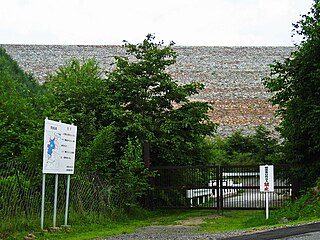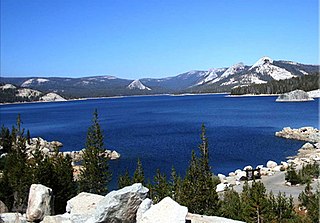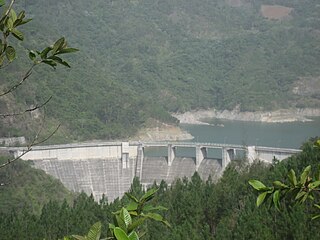
Folsom Powerhouse State Historic Park is a historical site preserving an 1895 alternating current (AC) hydroelectric power station—one of the first in the United States.

The Rubicon Hydroelectric Scheme is a small run-of-the-river hydroelectric scheme located on the Rubicon and Royston Rivers, north east of Melbourne, 40 km (25 mi) south-west of Alexandra, Victoria, Australia. The scheme commenced in 1922, and was the first state-owned hydroelectric scheme to generate electricity in mainland Australia, and among the first in the world to be remotely controlled. For the first ten years of its operation it supplied on average 16.9% of electricity generated by the State Electricity Commission of Victoria. It is now owned and operated by AGL Energy and contributes approximately 0.02% of Victoria's energy supply.

The Tokuyama Dam is an embankment dam near Ibigawa, Ibi District, Gifu Prefecture in Japan. The dam was completed in 2008 and will support a 153 MW hydroelectric power station that is expected to be fully operational in 2015. Unit 1 at 23 MW was commissioned in May 2014. The dam was originally intended to withhold the upper reservoir of a 400 MW pumped-storage power station until a design change in 2004. The dam is also intended for flood control and water supply. It is the largest dam by structural volume in Japan and withholds the country's largest reservoir by volume as well.

Ātiamuri Power Station is a hydroelectric power station on the Waikato River, in the North Island of New Zealand. It is the third of eight hydroelectric power stations on the Waikato River. The station can easily be seen from State Highway 1 between Taupō and Tokoroa.

Maraetai Power Station is a hydroelectric power station on the Waikato River, in the North Island of New Zealand. It is the fifth of the eight hydroelectric power stations on the Waikato River, and at 360 MW, is the largest hydroelectric station on the Waikato.

The Siah Bisheh Pumped Storage Power Plant, also spelled Siyāhbisheh and Siah Bishe, is located in the Alborz Mountain range near the village of Siah Bisheh and 48 km (30 mi) south of Chalus in Mazandaran Province, Iran. The power plant uses the pumped-storage hydroelectric method to generate electricity during periods of high energy demand, making it a peaking power plant, intended to fulfill peak electricity demand in Tehran 60 km (37 mi) to the south. When complete it will have an installed generating capacity of 1,040 megawatts (1,390,000 hp) and a pumping capacity of 940 megawatts (1,260,000 hp). Planning for the project began in the 1970s and construction began in 1985. It was delayed from 1992 until 2001 and the first generator went online in May 2013. The remaining generators were commissioned by 1 September 2015. The power plant is the first pumped-storage type in Iran and will also use the country's first concrete-face rock-fill dam – two of them.

The Cruachan Power Station is a pumped-storage hydroelectric power station in Argyll and Bute, Scotland, UK. The scheme can provide 440 MW of power and produced 705 GWh in 2009.

The Upper Kotmale Dam is located in Talawakele, within the Nuwara Eliya District, in the Central Province of Sri Lanka. The dam feeds the third largest hydroelectric power station in the country.

Stave Falls Dam is a dual-dam power complex on the Stave River in Stave Falls, British Columbia, Canada. The dam was completed in 1912 for the primary purpose of hydroelectric power production. To increase the capacity of Stave Lake, the dam was raised in 1925 and the Blind Slough Dam constructed in an adjacent watercourse 500 m (1,600 ft) to the north, which was the site of the eponymous Stave Falls. In 2000, the dam's powerhouse was replaced after a four-year upgrade. The original Stave Falls powerhouse was once British Columbia's largest hydroelectric power source, and is a National Historic Site of Canada.

The Kazunogawa Pumped Storage Power Station is a pumped-storage hydroelectric power station near Kōshū in Yamanashi Prefecture, Japan. The station is designed to have an installed capacity of 1,600 megawatts (2,100,000 hp) and three of the four 400 megawatts (540,000 hp) generators are currently operational, for a total operational capacity of 1200 MW. Construction on the power station began in 1993 and the first generator was commissioned on 3 December 1999. The second was commissioned on 8 June 2000. The third one became operational on 9 June 2014, six year early due to post-power demand from the Great East Japan earthquake. The fourth and final generator is slated to be commissioned by 2024. It is owned by TEPCO and was constructed at a cost of US$2.2 billion.

The Entracque Power Plant, also known as The Upper Gesso Plant, is a pumped-storage hydroelectric power station located in Valle Gesso just south of Entracque, Italy. The power station contains pump-generators for two co-located but hydraulically separated power schemes; the Chiotas-Piastra Plant and Rovina-Piastra Plant. Both plants use separate upper reservoirs but use Lago della Piastra as their common lower reservoir. To produce power, water is released from the upper reservoirs to the power station located at the lower reservoir. The pump-generators re-fill the reservoirs and the process repeats as needed. The Chiotas' upper reservoir, Lago del Chiotas, is located much higher in the valley and larger than Rovina's Lago della Rovina which affords it the ability to produce more electricity. The installed capacity of Chiotas is 1,184 megawatts (1,588,000 hp) with a hydraulic head of 1,048 m (3,438 ft) while Rovina has an installed capacity of 133.67 megawatts (179,250 hp) and a head of 598 metres (1,962 ft). Construction on the plant began in 1962 and operations started in 1982. It is owned and operated by Enel.

The Helms Pumped Storage Plant is located 50 mi (80 km) east of Fresno, California in the Sierra Nevada Mountain Range's Sierra National Forest. It is a power station that uses Helms Creek canyon on the North Fork of the Kings River for off-river water storage and the pumped-storage hydroelectric method to generate electricity. After being planned in the early 1970s, construction on the plant began in June 1977 and commercial operations began on 30 June 1984. It has an installed capacity of 1,212 MW and is owned by Pacific Gas and Electric Company.

The Edolo Pumped Storage Plant is located along the Oglio River just downstream of Edolo, Brescia Province in the Lombardy region of Italy. Using the pumped-storage hydroelectric method, it has an installed capacity of 1,000 megawatts (1,300,000 hp). Its generators were commissioned between April 1984 and November 1985. Lake Avio was previously completed in 1929 and Lake Benedetto completed in 1940.
The Nadarivatu Dam, also known as the Korolevu Dam, is a concrete gravity dam on the upper reaches of the Sigatoka River in Nadarivatu District of Nadroga-Navosa Province, Fiji. The primary purpose of the dam is to generate hydroelectric power in a 41.7 megawatts (55,900 hp) run-of-the-river scheme. The Nadarivatu Hydropower Scheme was first identified in 1977 during a hydropower study. Detailed plans for the project were developed in 2002 and major construction began in 2009. The power station was commissioned on 7 September 2012 but an inauguration ceremony led by Prime Minister Frank Bainimarama was held a week later on 14 September. Funding and loans for the project was provided by several organizations to include the China Development Bank, Fiji Electricity Authority bonds, ADZ Bank. The 40 m (130 ft) tall dam diverts water from the Sigatoka River through a 3,225 metres (10,581 ft) long headrace/penstock tunnel to a power station along the Ba River to the southwest. The power station contains two 20.85 megawatts (27,960 hp) Pelton turbine-generators. The drop in elevation between the reservoir and the power station affords a gross hydraulic head of 335.7 metres (1,101 ft).
The Afulilo Dam is a gravity dam on the Afulilo River about 3 km (1.9 mi) south of Ta'elefaga in the district of Va'a-o-Fonoti on Upolu island of Samoa. The primary purpose of the dam is hydroelectric power generation and it supports a 4 megawatts (5,400 hp) power station. It is the largest hydroelectric power station by installed capacity in Samoa. First studied in 1980, construction on the project began in 1990 and the power station was commissioned in 1993. Funding for the US$26.6 million project was provided by the World Bank, Asian Development Bank, International Development Association, European Investment Bank, and European Economic Community loans and grants.

The Jigüey Dam is an arch-gravity dam on the Nizao River about 32 km (20 mi) west of San Cristóbal in San José de Ocoa Province of the Dominican Republic. At 110.5 m (363 ft) tall, it is the third highest dam in the country. The purpose of the dam is to produce hydroelectric power and it supplies the largest hydroelectric power station in the country.
The Zhanghewan Pumped Storage Power Station is a pumped-storage hydroelectric power station located 50 km (31 mi) southwest of Shijiazhuang in Jingxing County of Hebei Province, China. Construction on the power station began on 6 December 2003 and the first unit was commissioned on 1 February 2009. The power station operates by shifting water between an upper and lower reservoir to generate electricity. The lower reservoir is created by the Zhanghewan Dam on the Gantao River which was built between 1977 and 1980, originally for irrigation. For this project the Zhanhewan Dam was raised 23 m (75 ft). The Zhanghewan Upper Reservoir is on Laoyemiao Mountain, above the west side of the lower reservoir. During periods of low energy demand, such as at night, water is pumped from Zhanghewan Lower Reservoir up to the upper reservoir. When energy demand is high, the water is released back down to the lower reservoir but the pump turbines that pumped the water up now reverse mode and serve as generators to produce electricity. The process is repeated as necessary and the plant serves as a peaking power plant.

The St. Margaret's Bay Hydroelectric System consists of three hydroelectric power plants and the related lake, dam, and river systems driving them. The system is situated within both Lunenburg County and the Halifax Regional Municipality, beginning approximately 2.5 km (1.6 mi) east of the Head of Saint Margarets Bay and approximately 10 km (6.2 mi) southwest of Hammonds Plains. The system is part of the East Indian River watershed and drains 271 square kilometres (105 sq mi), with water storage provided in Lunenburg County by Mill Lake, Coon Pond, Sandy Lake, Wrights Lake, Big Indian Lake, Five Mile Lake and, at times, an overflow from Pockwock Lake in the Halifax Regional Municipality. The system is owned and operated by Nova Scotia Power Inc.

Escaldes Hydroelectric Power Station is located in Engolasters of the Encamp parish in Andorra. Its namesake, Les Escaldes, is located just to the south in Escaldes-Engordany parish. It uses water from Lake Engolasters, located 1,616 metres (5,302 ft) above sea level in order to generate hydroelectricity. A 1,250 metres (4,100 ft) long penstock deliver water from the 178 m (584 ft) long Engolasters Dam to the power station which contains two 14 MW and one 17 MW Pelton turbine-generators. The difference in elevation between the lake and power station is about 490 metres (1,610 ft).

The Snoqualmie Falls Hydroelectric Plant is located just north of Snoqualmie in King County, Washington state, US. It is situated about 22 mi (35 km) east of Seattle. Located just below the Snoqualmie Falls, the power plant consists of two power houses, Plant 1 and Plant 2. Plant 1 was completed in 1899 and is located underground. It is the first completely underground hydroelectric power plant ever built in the world. Plant 2 was built in 1910 and is located along the right bank of the Snoqualmie River. Both plants receive water from a small reservoir created by a weir atop the falls. Plant 1 has an installed capacity of 13.7 MW and Plant 2 a capacity of 40.2 MW for a total installed capacity of 53.9 MW, enough to power 40,000 homes.
















